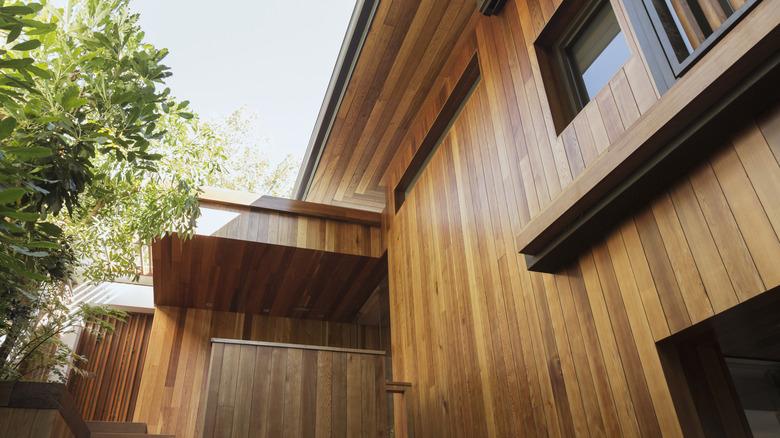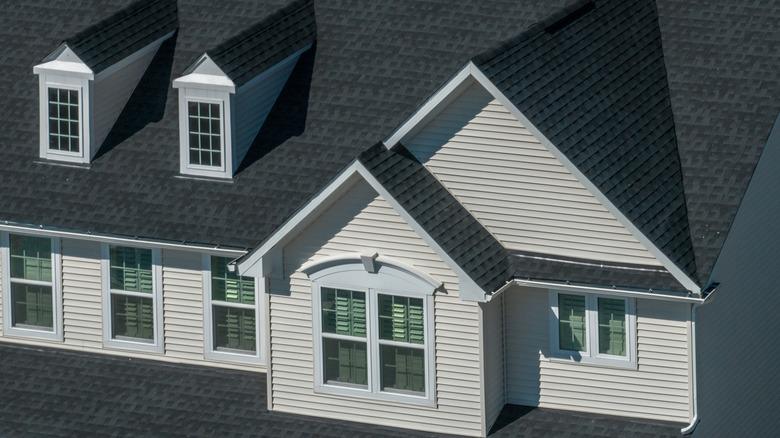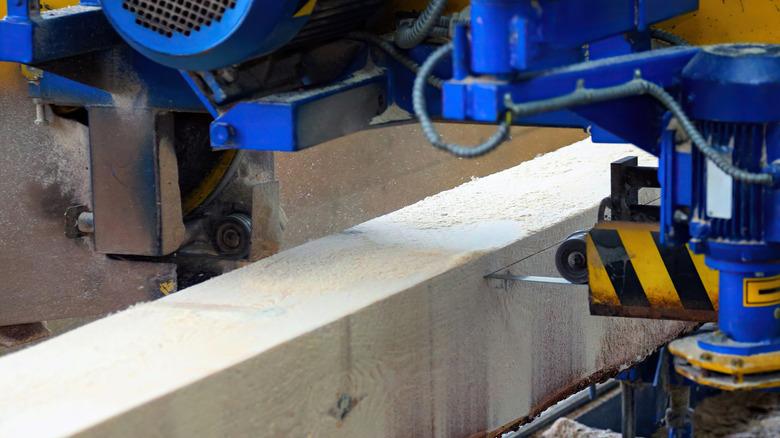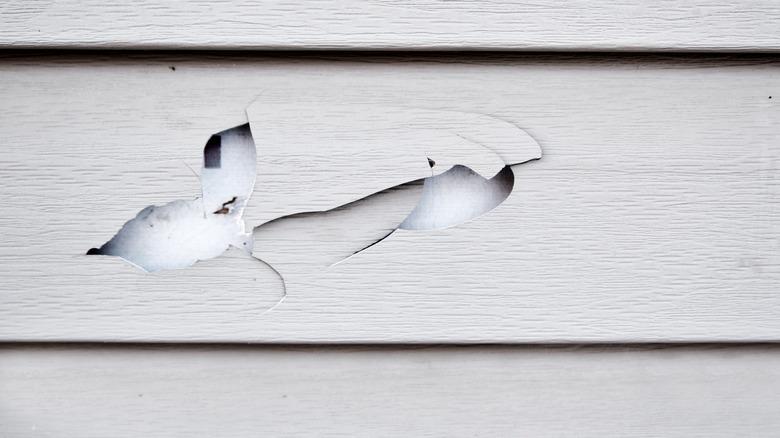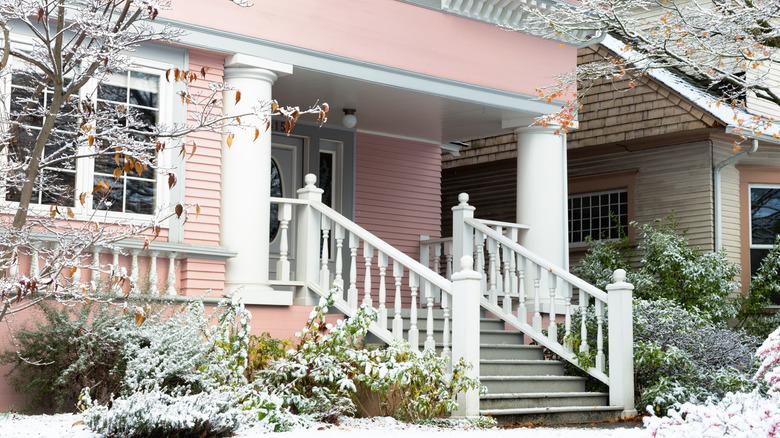Wood Siding Vs. Vinyl Siding: Which Is Right For Your Home?
Siding is one of the first things anyone sees when they visit your home. And it's an important detail to consider when buying a home. Is one type of siding, wood or vinyl, a better value? How do you know if it's right for your home? Siding is important aesthetically, but it also protects your house. It keeps the weather out, as well as helping pests stay outside where they belong. As an expert woodworker who has hung his fair share of siding, I have insights regarding which type of siding is the best bet for homeowners. The two most popular types of siding under consideration are wood and vinyl — and they're popular for good reasons. Aluminum, steel, and constructed siding are not as common. In my view, wood siding edges out vinyl siding, but there are many situations to consider.
While it may seem obvious, vinyl is a man-made material. It's a poly-vinyl chloride, or the ubiquitous PVC plastic. PVC is used in a huge variety of ways, with the basic formula modified for specific uses. Vinyl siding is durable and can be colored in a wide range of colors and hues. It is manufactured by extrusion and has been in the market (and on houses) for decades. Wooden siding comes from trees (to continue being obvious). Cedar siding is the most popular kind of wood siding, followed by pine due to its more economical price. Redwood siding used to be popular because of its beauty and weather-resistant properties, but is now quite expensive. Spruce and fir are also used, but not as often. But which one is right for your home?
Wood siding vs. vinyl siding: Cost factors
Cost must always be considered when it comes to any construction project. And there is a significant difference in price between vinyl and wooden siding, especially when it comes to the initial purchase. It is not uncommon for wooden siding to cost twice as much (perhaps a bit more) than vinyl per square foot. While prices fluctuate, rough estimate costs for vinyl goes for around $2 to $3 per square foot. Wood is $2 to $6 per square foot.
Another factor is that wood is more expensive to have installed. It requires more tools, measuring and skill than installing vinyl. And finally, wood requires more maintenance and generally will not last as long as vinyl siding. With that said, there are also quality levels in vinyl siding and you will pay more for higher quality.
All that would make one think that vinyl is the clear cost winner. However, wooden siding is often considered more valuable and holds a better return on investment (ROI) than vinyl. That's because wood siding can be installed in a variety of ways with custom patterns like classic board and batten design, along with styles basically only limited by the imagination of the designer. And while vinyl siding comes in a wide range of colors, wooden siding can be painted any color that a person desires. That customization will create more value and will retain that value over time. So, the value equation is a bit more complicated than simply cost of purchase and installation.
Wood siding vs. vinyl siding: Environmental & sustainability factors
While price is often the determining bottom-line factor, I know that I have sustainability and environmental responsibility considerations when I am building projects, including my home. Vinyl siding is plastic, as you may recall. The good news is that vinyl sides can be recycled — in fact, there are specific processes for recycling vinyl. The downside is that the recycling centers for vinyl are less common than for other plastics. Often, vinyl siding simply gets shipped to a landfill where it will remain until the end of time.
Wood siding is an ecologically sound material. You may think that as an expert woodworker, I am biased in my opinion, but let me explain. Trees capture carbon and store it. When we make things from the wood that trees provide, that carbon remains sequestered from the atmosphere. By sustainably managing forests, we can increase the amount of carbon that is absorbed. Young trees capture more of it. It is estimated that forests are currently storing 662 billion tons of carbon!
Forests also provide for environmental diversity. Making wooden siding does not require the chemical or energy input that vinyl does. And finally, when wood is discarded, even in a landfill, it will naturally break down. And most wood used in construction is sustainably harvested. Organizations like the Forest Stewardship Council (FSC) are independent third parties that verify sustainably harvested wood. The environmental problem of deforestation is primarily associated with agricultural practices of turning forest land into farmland. So, for my money, wood siding is the much better product when environmental costs are considered.
Wood siding vs. vinyl siding: Longevity & maintenance factors
The question of how often you will need to replace a product is important when you are making a purchase. Both wood siding and vinyl siding will last a long time. However, vinyl siding is commonly considered to be viable for up to 40 years. That is a long time. The longevity of wood siding depends. When well-maintained, wooden siding can last decades. That said, it can be susceptible to wood-eating insects, and rarely, could crack or warp. In 1990 I purchased a house built in 1906, which still had its original 3-inch redwood siding holding up well. We can agree that my siding may have outperformed all expectations, but 80-plus years is nothing to sneeze at.
The beauty of vinyl siding is that it requires almost no maintenance. Cleaning it with a Westinghouse power washer or just a hose and brush will keep it in tip-top shape. Because it's an extruded shape and is brittle to a degree, hail strikes and similar events can fracture or crack vinyl siding. The broken siding will need to be replaced. Many installers will leave the homeowner additional "extra" siding for just this sort of problem. Cracked vinyl siding is not an uncommon problem either. Wood siding stands up well to the weather, including hail. It does need to be painted (or stained) on a regular schedule, every 5 to 10 years, which is no small job. And while that can be a negative, it also gives you the option of changing the color of your house, which is complicated with worn-out vinyl siding.
Overall winner: wood or vinyl?
Considering all the information above, you may still be wondering which type of siding will be right for your home. First off, it must be stated that either will do the job of protecting your home. They've stood the test of time. And without a doubt, vinyl will cost less to purchase and install. Crews that install vinyl siding do it quickly and at a reasonable cost. Beauty is indeed in the eye of the beholder, but most people will concede that while vinyl is not ugly, its aesthetic is limited. It looks like vinyl siding, and even the faux wood grain is fooling no one. Additionally, its insulation value is less than wood's. If you have it applied over existing siding, the window treatments can look a little clunky.
Wood siding will cost you more per square foot and for installation, perhaps as much as three times more. It also requires regular painting or staining — an additional cost. It has slightly better insulation than vinyl. Wood exterior siding can boost curb appeal, too. Its versatility can really enhance the look of your house in a way that vinyl simply can't. That makes it more pleasing to look at and better for resale. Its carbon footprint is much lower than vinyl, and it's an entirely sustainable material.
Cost can never be ignored when considering a home improvement project, but in my mind, the value equation leans toward wood siding. It may be out of your budget and that's critical to consider. But if you can afford the higher cost, wooden siding is my recommended way to go.
